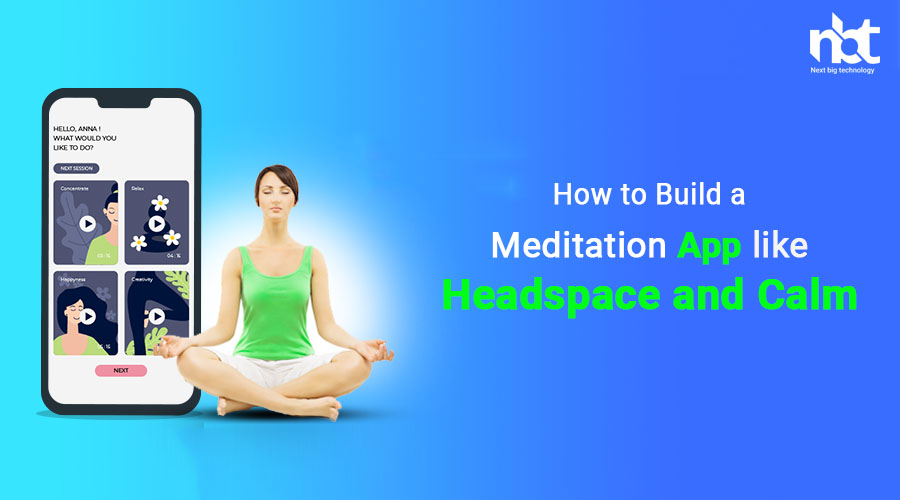Introduction: Meditation apps like Headspace and Calm have gained immense popularity as they provide convenient access to guided meditation and mindfulness practices. If you’re interested in building your own meditation app and offering users a serene and mindful experience, this blog will guide you through the essential steps. We will explore the key features, design considerations, development process, and best practices to create a meditation app that resonates with users and helps them cultivate inner peace and well-being.
- Understanding the Meditation App Landscape: Before diving into the development process, it’s crucial to understand the landscape of meditation apps and familiarize yourself with popular apps like Headspace and Calm. Explore their features, content offerings, and user experiences. This will provide insights into the features that users expect and help you identify unique elements to incorporate into your own app.
- Define Your App’s Unique Selling Points: To stand out in the competitive meditation app market, it’s important to define your unique selling points (USPs). Determine what sets your app apart from others and how it will provide value to users. This could include personalized meditation recommendations, specific meditation programs tailored to different needs (e.g., stress reduction, sleep improvement), or unique content such as music, nature sounds, or calming visuals.
- Key Features of a Meditation App: To create a compelling meditation app, consider integrating the following key features: a. Guided Meditations: Offer a library of guided meditation sessions led by experienced teachers or meditation experts. b. Meditation Programs: Curate meditation programs or courses that users can follow to achieve specific goals or develop mindfulness habits. c. Sleep and Relaxation Content: Provide soothing music, ambient sounds, or guided sleep meditations to aid relaxation and improve sleep quality. d. Progress Tracking: Enable users to track their meditation journey, set goals, and view their progress over time. e. Reminder and Notification System: Send reminders to users to encourage consistent practice and offer personalized recommendations. f. Community and Social Features: Create a sense of community by allowing users to connect, share experiences, and provide support to one another. g. Mindfulness Tools: Incorporate additional tools like breathing exercises, gratitude journals, or mindful reminders to enhance the user experience. h. Offline Access: Allow users to download content for offline access, enabling them to meditate even without an internet connection.
- Design Considerations: When designing a meditation app, keep the following considerations in mind: a. Simplicity and Ease of Use: Strive for a clean and intuitive user interface that enables seamless navigation and a distraction-free meditation experience. b. Calming Visuals and Sound Design: Use soothing colors, minimalist design elements, and high-quality audio to create a serene and immersive experience. c. Personalization and Customization: Provide options for users to personalize their meditation sessions by choosing durations, themes, or instructors that resonate with them. d. Accessibility: Ensure your app is accessible to a wide range of users by offering adjustable text sizes, audio options, and support for different languages. e. Compatibility and Responsive Design: Optimize your app for various devices and screen sizes, including smartphones and tablets, to cater to a larger user base.
- Development Process: The development process of a meditation app typically involves the following stages: a. Requirement Analysis: Define the app’s features, functionality, and user experience based on your research and target audience. b. Design: Create wireframes, mockups, and user interface designs to visualize the app’s layout and flow. c. Backend and API Development: Develop the server-side infrastructure, database management, and integrate necessary APIs for content delivery and user authentication. d. Frontend Development: Implement the user interface design and ensure smooth app performance across different platforms. e. Content Creation: Collaborate with meditation experts or instructors to create high-quality guided meditations and other content. f. Testing and Quality Assurance: Conduct rigorous testing to ensure the app functions properly, is free of bugs, and provides an optimal user experience. g. Deployment and App Store Submission: Prepare the app for deployment on app stores, adhering to the guidelines and requirements of platforms like the Apple App Store and Google Play Store.
- Best Practices for Meditation App Development: To create a successful meditation app, consider these best practices: a. Content Curation: Regularly update and expand your meditation library with new sessions, programs, or guest instructors to keep users engaged and coming back for more. b. User Feedback and Iteration: Actively gather user feedback through surveys, reviews, or in-app analytics to understand user preferences and make necessary improvements. c. Mindful Onboarding: Guide users through the onboarding process with clear instructions and a welcoming experience that introduces them to the app’s features and benefits. d. Gamification and Rewards: Implement gamification elements, such as badges, streaks, or milestones, to motivate users and enhance their sense of achievement. e. Privacy and Data Security: Ensure the app complies with privacy regulations and clearly communicates how user data is collected, stored, and used. f. Seamless Integration with Wearable Devices: Explore the integration of your meditation app with popular wearable devices, such as smartwatches, to offer users more flexibility and convenience.
Conclusion: Developing a meditation app like Headspace or Calm requires careful planning, a user-centered approach, and attention to detail. By understanding the landscape, defining unique selling points, incorporating key features, and following design best practices, you can create a captivating and serene meditation app that helps users cultivate mindfulness, reduce stress, and improve overall well-being. Remember to prioritize simplicity, personalization, and a seamless user experience to ensure your app stands out in the competitive meditation app market and resonates with users seeking moments of calm in their daily lives.










